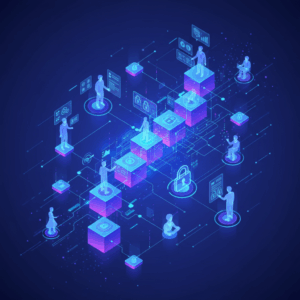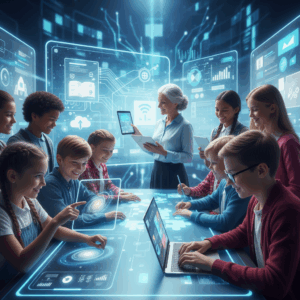Overview of Smart Learning Platforms
Smart learning platforms leverage AI technology to create highly personalized educational experiences. These platforms continuously analyze student data to adapt content and pace.
By assessing responses and interaction patterns in real time, smart learning systems tailor lessons to meet the unique needs of each learner, enhancing engagement and effectiveness.
This dynamic approach contrasts with traditional static courseware, providing students with a more tailored and efficient path to mastery.
Personalization through Real-Time Data Analysis
These platforms gather and analyze data such as student answers, timing, and behavior during lessons. This allows immediate adjustment of content to optimize learning.
AI algorithms identify strengths and weaknesses, modifying lesson difficulty or format to maintain an ideal challenge for each student, supporting steady progress.
Such personalization promotes deeper understanding and retention by adapting teaching strategies on the fly according to learner performance.
Examples: DreamBox and Smart Sparrow
DreamBox uses AI to automatically adjust math lesson difficulty, allowing students to learn at their own pace with appropriate challenges and support.
Smart Sparrow customizes e-learning content based on interaction data, ensuring learners remain engaged and receive explanations suited to their comprehension levels.
Key Features of These Platforms
Both platforms employ continuous assessment and adaptive feedback, creating responsive learning environments that maximize student potential through tailored instruction.
Functionalities of Adaptive Teaching Systems
Adaptive teaching systems utilize AI to continuously gather data during student interactions, capturing not only responses but also behavioral cues. This enables a deeper understanding of learning progress and challenges.
By interpreting these behavioral signals, such as pauses or repeated attempts, the systems adjust instruction dynamically, addressing unique learner needs and fostering effective engagement.
These adaptive mechanisms ensure lessons evolve in real time, creating a more personalized and supportive learning journey tailored to individual performance.
Continuous Data Gathering and Behavioral Signals
These systems collect extensive data on student behavior, including response times, error patterns, and engagement levels. Such data provides insights beyond simple right or wrong answers.
Behavioral signals like hesitation or frequent revisions help identify areas of confusion, allowing the system to intervene with suitable content or activities that address those challenges.
This continuous monitoring enables a responsive learning environment where the educational path shifts to optimize student understanding and motivation.
Insight into Student Behavior
By analyzing subtle behavioral cues, adaptive systems create rich profiles that drive more precise personalization, making learning experiences more intuitive and effective.
Machine Learning and Recommendation Engines
Machine learning powers recommendation engines that suggest the next best instructional material based on student data and learning context. This creates a tailored progression through content.
Instead of relying on static rules, the engines evolve by learning from accumulated data, enhancing their capability to recommend resources that best support individual mastery.
Recommendations can include simpler explanations, interactive simulations, or assessments, ensuring that learners receive appropriate challenges and reinforcement.
Natural Language Processing for Interactive Learning
Natural language processing (NLP) allows students to interact with systems using their own words, asking questions and receiving instant, contextually relevant responses. This fosters a more natural dialogue.
NLP-based tools simulate tutor-like interactions, helping students clarify doubts and deepen understanding without waiting for human assistance, thus enhancing learner autonomy.
Through conversational AI, adaptive teaching platforms improve engagement by providing immediate explanations and personalized feedback tailored to each student’s queries.
Additional AI Capabilities in Education
AI enhances education beyond personalized learning, offering tools like automated grading and virtual tutoring to streamline classroom workflows and support diverse learner needs.
These technologies boost efficiency by saving educators time on routine tasks while providing students with instant, adaptive assistance, enriching their overall educational experience.
Immersive AI-driven technologies such as virtual reality (VR) and augmented reality (AR) open new pathways for experiential and interactive learning environments.
Automated Grading and Virtual Tutoring
Automated grading systems leverage AI to quickly and accurately assess student work, reducing human error and freeing educators to focus on teaching and student interaction.
Virtual tutoring platforms simulate personalized instruction by interpreting student queries and delivering tailored explanations, promoting learning outside conventional classroom settings.
Examples like Gradescope automate exam grading, while AI tutors such as Khan Academy’s assistants provide 24/7 support, enhancing access and responsiveness to individual learner needs.
Immersive Technologies: VR and AR
Virtual reality immerses students in interactive simulated environments, making abstract concepts tangible and improving engagement through experiential learning.
Augmented reality overlays digital information on physical surroundings, enriching real-world experiences with educational content, fostering deeper understanding.
Engagement Through Immersive Learning
Using VR and AR, educators can create dynamic lessons that adapt to student responses, promoting active participation and improving retention through hands-on experiences.
These immersive technologies enable field trips, lab experiments, and complex visualizations remotely, breaking traditional barriers and enhancing accessibility for all learners.
Impact on Students and Educators
The integration of AI in education significantly transforms experiences for both students and educators. It enables personalized learning while providing tools that enhance teaching efficiency.
Students benefit from tailored content and immediate feedback, which supports independent learning and helps address individual challenges effectively.
At the same time, educators gain valuable insights into student progress and reduced administrative burden, allowing them to focus on more meaningful instructional activities.
Enhanced Student Learning and Feedback
AI-powered platforms deliver customized learning paths that adapt to each student’s pace and level, promoting deeper understanding and long-term retention.
Immediate, personalized feedback helps students recognize mistakes and learn actively, fostering motivation and consistent progress throughout their studies.
This dynamic interaction simulates a one-on-one tutoring environment where learners receive support tailored to their unique needs.
Teacher Support and Workload Reduction
AI tools automate time-consuming tasks such as grading and progress tracking, freeing educators to focus on personalized instruction and student engagement.
By providing detailed analytics on student performance and learning gaps, AI assists teachers in making informed decisions and intervening proactively.
Overall, these technologies reduce administrative workload and enhance teachers’ capacity to support diverse learners more effectively.






